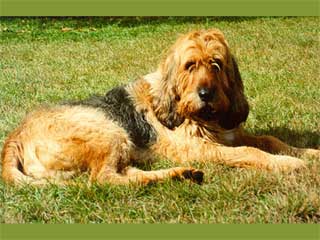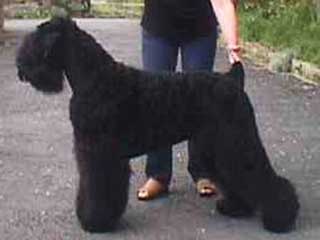| Grooming: |  |  |  |  |  |  |
| Shedding: |  |  |  |  |  |  |
| Energy Level: |  |  |  |  |  |  |
| Protection: |  |  |  |  |  |  |
| Watch Dog: |  |  |  |  |  |  |
| Group: | Hound |
| Size: | Large |
| Life Span: | 10-12 years |
| Height: | Male: 26-28 inches |
| Female: 23-25 inches | |
| Weight: | Male: 110-120 lbs |
| Female: 70-90 lbs |
Otterhound Facts
| Coat : | Outer coat is dense & rough. Undercoat is soft & wooly |
| Gait : | Smooth and effortless |
| Color(s) : | Any |
| Living Area : | Large |
| Hair Length: | Long |
| Exercise Need : | Daily long walk, Jogging, Swimming |
| Recognized By : |
(FCI) F�d�ration Cynologique Internationale (AKC) American Kennel Club (KCGB) Kennel Club of Great Britain (CKC) Canadian Kennel Club (NKC) National Kennel Club (NZKC) New Zealand Kennel Club (CKC) Canadian Kennel Club (APRI) America Pet Registry, Inc. (ACR) American Canine Registry (DRA) Dog Registry of America |
| Date of Origin : | Ancient |
| Place of Origin : | France |
| Todays Use : | Guard Dog |
| Originally Used : | Otter hunter |
| Other Name : |
Otterhound Information
Otterhound Description:The origin of the Otterhound lies in France. Although the exact origin of the breed is unknown, it is believed to be result of cross breeding between the Bloodhound and the Terriers. The breed derives its name from its ability to hunt otters. The breed has a great sense of smell which was used in olden days to hunt otters. The Otterhounds were bred after the otters began to pose a threat to fish supply. However, by the 20th century, the numbers of this breed dwindled and it was included in the category of endangered dog breeds. Through dedicated breeding programs, this breed was saved from extinction, but is never managed to regain the popularity it once enjoyed. The breed was first recognized by the AKC in 1909. |
Otterhound Care & Grooming:The Otterhound is an average shedder. Its rough and thick coat is easy to maintain. Brushing its coat once or twice in a week with a firm bristle brush and almost daily brushing during shedding season is sufficient to maintain a healthy looking coat. It should be bathed only when necessary. However, extra care should be taken of its feet since it is a heavy breed and a lot of pressure is put on the feet. Regular trimming of the nails is advised to avoid injuries. Its eyes and ears should be cleaned properly to avoid any infection. The hair around its eyes, ears and paws shold be trimmed regularly. Its beard should be cleaned daily to remove any food remains. |
Otterhound Health Problems:The Otterhound is prone to some health issues like hip and elbow Dysplasia, Hemophilia, Bloat etc. |
| Group: | Herding |
| Size: | Medium |
| Life Span: | 12-15 years |
| Height: | Male: 19-22 inches Female: 18-21 inches |
| Weight: | Male:30-45 lbs Female: 25-40 lbs |
| Color: | Any solid color, bi-color or tri-color |
| Description: | The exact origin of the Border Collie is relatively unknown. However, it is believed to hav..... |










